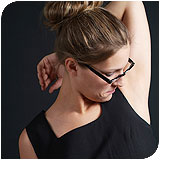 Hyperhidrosis, or excessive sweating, is a relatively common condition which potentially interferes with personal and professional life. Focal hyperhidrosis commonly affects the underarms (axilla) or palms. Less frequently it can occur in other areas including the face, under the breasts and inguinal area. When it is in the inguinal area (typically the bikini area in women) - it is also known as Hexsel's hyperhidrosis. All forms of hyperhidrosis can be socially embarrasing and cause patients severe distress.
Hyperhidrosis, or excessive sweating, is a relatively common condition which potentially interferes with personal and professional life. Focal hyperhidrosis commonly affects the underarms (axilla) or palms. Less frequently it can occur in other areas including the face, under the breasts and inguinal area. When it is in the inguinal area (typically the bikini area in women) - it is also known as Hexsel's hyperhidrosis. All forms of hyperhidrosis can be socially embarrasing and cause patients severe distress.
Oral medications are not usually very effective for this condition and until recently only surgery could be offered. Surgery involved removing a group of nerve cells located near the first rib called the superior cervical ganglion. This surgery can have significant side effects. More recently, it has been recognized that botulinum toxin can easily and effectively treat this common condition.
At Bellaire Neurology, Dr. Loftus treats primary axillary hyperhidrosis, forehead, inguinal, and palmar hyperhidrosis with botulinum toxin type A(Botox® or Dysport®) and B (Myobloc®). Botulinum toxin inactivates acetylcholine nerve endings. The axillary area (underarm) contains mostly eccrine sweat glands that generate most of the sweat. These glands are innervated by acetylcholine nerve fibers. The injection itself is mildly uncomfortable in the axilla but moderately uncomfortable in the hand. Topical anesthetics can be used to reduce the pain. It is rare to get any systemic side effects except that botulinum toxin type B commonly causes a mild dry mouth.
Botulinum toxin requires binding to Zinc in order to function. Dr. Soparker and associates demonstrated that the use of Zytaze (a combination of Zinc and phytase) resulted in extending the benefit of botulinum toxin (at least Botox brand for blepharospasm and forehead wrinkles). Given the low cost, Dr. Loftus recommends all of his patients use Zytaze when using botox for hyperhidrosis.
The best dosing for this procedure is not entirely clear. A recent study published in the April 2002 Journal of American Academy Dermatology suggested that high dose Botox - 200 units per axilla produced a longer period of time between treatments. In their study, 1 in 8 relapsed within one year, with 2 out of 3 lasting more than 19 months. The longest effect was seen in one patient who had been followed for 29 months. In contrast, studies with 50 units per axilla varied from 100% relapse after 7 months to a high percentage going beyond 8 months but not one year. In general, the treatment is priced per unit and therefore it appears to me that the most cost effective dose may be in the 50 unit per axilla range as it is not clear that the 4 times dosing gives a 4 times longer response.
The method used to apply the botulinum toxin varies as well. Various dilutions of botulinum toxin can be used as well as an iodine starch test to identify those areas of maximally sweat output. Treatment cost for both underarms or the forehead typically costs about $1000 total. Treatment of both palms typically runs $1600. Patients preferring the higher dose botox therapy will obviously have to pay more but may feel it is more convenient to do so. Dysport brand of botulinum toxin A is some what less expensive than the Botox brand or Mybloc brand.
Patients who want to learn more about hyperhidrosis surgeries can visit many web pages. There are, however, a group of patients who are convinced there is long term harm with these procedures. I do not do surgery myself, I wish only that potential patients hear all sides of the story. Therefore, patients considering surgery are encouraged to read this web site. Potential patients are encouraged to email Dr. Loftus with questions in advance of an appointment.
Dr. Loftus injecting the left underarm. A series of injections are made in the underarm to treat axillary hyperhidrosis.




